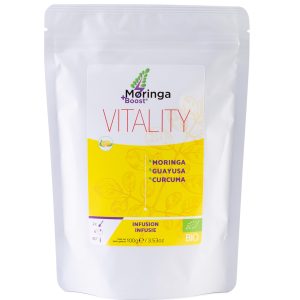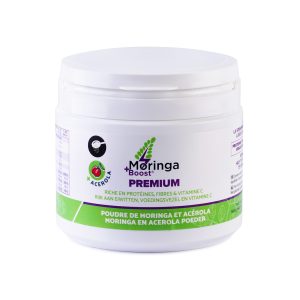Over the decades, intensive agriculture has played a central role in global food production, meeting the growing demand for agricultural products. However, this production method, characterized by intensive use of chemicals, widespread monoculture and inappropriate management practices, is not without consequences. It has a negative impact on the environment, human health and the sustainability of natural resources in general, and water resources in particular.
Faced with these concerns, many people are looking for alternatives that are more respectful of the environment and health. Among these alternatives, greenhouse farming has gained in popularity as a means of growing fruit and vegetables all year round. However, it’s essential to recognize the limitations of this method and consider healthier options, such as organic moringa plantations.
Let’s take a closer look at the dangers of intensive agriculture, the benefits of moringa plantations and highlight the implications of growing moringa in greenhouses.
● The dangers of intensive farming
Intensive agriculture, with its frequent use of chemical pesticides, synthetic fertilizers and monocultures, has widespread negative impacts. Here is an overview of the main hazards associated with this method of agricultural production:
Soil depletion
Monocultures and the intensive use of chemicals deplete soils of essential nutrients. This soil degradation requires ever more frequent use of chemicals to maintain productivity, creating a vicious circle.
Water pollution
The pesticides and chemical fertilizers used in intensive agriculture can seep into groundwater, contaminating drinking water sources. This has serious consequences for human health and the aquatic ecosystem. Intensive farming threatens the water table, but organic farming, in particular moringa cultivation, preserves these vital resources.
Deforestation
To create vast monocultures and pastures, areas of forest are often cleared. This leads to biodiversity loss, natural habitat degradation and the release of carbon dioxide into the atmosphere, contributing to climate change.
Loss of biodiversity
Monocultures and the intensive use of chemicals are reducing biological diversity, with devastating consequences for ecosystems and soil health.
Impact on human health
Pesticide residues in intensively farmed food products can have harmful effects on human health, including neurological disorders and cancer. Human health benefits directly from the consumption of organic produce, such as fresh fruit and vegetables.
● Greenhouse farming: an alternative to intensive agriculture
Fruit and vegetables grown in certified organic greenhouses offer a safer alternative to intensive cultivation. Greenhouse farming has become an attractive alternative to traditional agriculture, offering a means of growing fruit and vegetables all year round. However, it is important to note that this method is not without its challenges and potential problems:
Energy consumption
Greenhouses require a considerable amount of energy to maintain optimal environmental conditions. This energy may come from non-renewable sources, contributing to greenhouse gas emissions.
Use of chemicals
To maintain a pest-free environment and high yields, many greenhouses use chemical pesticides and synthetic fertilizers.
Plastic waste problems
Plastic waste from agricultural greenhouses can cause major environmental problems if not properly managed.
Concentration of production
Agricultural greenhouses are often used for large-scale production of specific crops, which limits crop diversity.
Dependence on non-renewable resources
Agricultural greenhouses often rely on non-renewable sources of seeds, which can pose long-term sustainability problems. New seeds, often GMO, have to be bought every year.
● Organic Moringa plantations: a healthy and sustainable alternative
Moringa, also known as the “miracle tree”, offers a healthier, more sustainable alternative to intensive farming and greenhouse cultivation. Strict organic farming specifications guarantee that products like moringa powder are grown without the use of harmful pesticides. Young plants, when cultivated in a sustainable manner, contribute to soil regeneration. Choosing certified organic seeds is essential to guarantee a crop free of synthetic chemicals.
Here’s how organic planting brings significant benefits:
Low water consumption
Thanks to its water-storing tuberous root, moringa is a drought-resistant plant that requires much less water than many traditional crops. This feature makes it a wise choice in drought-prone regions.
Organic farming
Moringa plantations are often organically farmed, which means they are free from chemical pesticides and synthetic fertilizers. This approach protects soil and water health.
Rich in nutrients
Moringa is one of the world’s most nutritious plants. Its leaves are rich in vitamins, minerals, antioxidants and essential amino acids. Adding this natural supplement to the diet contributes to nutritional satisfaction, and its high protein content can help reduce animal protein consumption.
Biological diversity
Plantations encourage biological diversity, as they are often cultivated in agroforestry. This approach involves combining moringa crops with other trees and plants, creating a richer ecosystem.
CO2 absorption
Moringa has the capacity to absorb large quantities of carbon dioxide from the atmosphere, helping to mitigate climate change.
Sustainable source of income
Moringa cultivation can provide a sustainable source of income for farmers, as every part of the plant, from leaves to seeds, is used for food and medicinal purposes. What’s more, it enables small farmers to make a decent living without having to own many hectares, as is the case with intensive farming, or make costly investments, as is the case with greenhouse cultivation.
● Growing Moringa in greenhouses: a comparative study
To better understand the differences between greenhouse farming and organic moringa plantations, let’s look at a detailed comparison:
Water consumption
Agricultural greenhouses, while allowing for more precise water control, require considerable use of water to maintain optimal environmental conditions. Moringa, on the other hand, is a drought-resistant plant, requiring less water for growth.
Use of chemicals
Greenhouses often use chemical pesticides and fertilizers to maintain a pest-free environment. Organic plantations avoid the use of synthetic chemicals, thus contributing to soil health and water purity.
Cultural diversity
Agricultural greenhouses are often used to grow specific crops on a large scale, which limits crop diversity. Moringa plantations encourage biodiversity, as they are often cultivated in agroforestry systems.
Long-term durability
Agricultural greenhouses often rely on non-renewable sources of energy, which can pose long-term sustainability problems. Moringa plantations are a more sustainable option due to their low water consumption, organic farming and role in carbon sequestration.
● Uses of Moringa in Organic Agriculture
Moringa powder-based dietary supplements are increasingly sought-after for their anti-inflammatory properties. The powder, used as a dietary supplement, is an example of a product with health benefits that can be incorporated into a balanced diet. It is a versatile plant with many uses in organic farming, including :
Organic fertilization
Once the leaves have been harvested, the moringa stems are crushed and used as organic fertilizer to improve soil fertility.
Power supply
Moringa leaves are edible and rich in nutrients, making them a valuable staple in the fight against malnutrition. Prestigious organizations such as the Red Cross and Action contre la Faim recommend its cultivation in regions where malnutrition is rife.
Natural medicine
Moringa has been used for centuries in traditional medicine, particularly Ayurvedic medicine, for its healing properties. It can be used to treat a variety of health problems, including malnutrition, hypertension, diabetes and inflammation.
Breeding
Moringa leaves and stems that do not have all the qualities required for human consumption can be used as livestock feed, improving their health and productivity.
● Conclusion
Sustainable agricultural systems are crucial to preserving our environment.
Intensive agriculture, greenhouse farming and organic moringa plantations are very different approaches to meeting society’s food needs. Intensive agriculture, while helping to feed the world’s population, has had a considerable impact on the environment, human health and the sustainability of resources.
Although greenhouse farming enables more regular production of fruit and vegetables, it also presents challenges in terms of energy consumption, chemical use and plastic waste management.
Organic moringa plantations, on the other hand, offer a healthier, more sustainable alternative. The plant requires little water, promotes biodiversity, helps reduce deforestation and is a source of valuable nutrients.
By including this natural supplement in your diet, you support environmentally-friendly agriculture and benefit from its many health advantages. It’s time to reflect on our food choices and promote sustainable farming practices for the sake of the planet and our own health. With moringa, we can cultivate a healthier, more sustainable future in harmony with nature.
References
- Scientific research on the effects of moringa: https: //www.asbestos.com/blog/2019/11/26/moringa-tree-cancer-research/
- Medicinal benefits of the moringa plant: https: //www.fic.nih.gov/News/GlobalHealthMatters/january-february-2020/Pages/carrie-waterman-studies-moringa-plants-medicinal-nutritional-benefits.aspx
- Physiological properties of Moringa oleifera: https: //www.mdpi.com/1660–4601/18/5/2322










